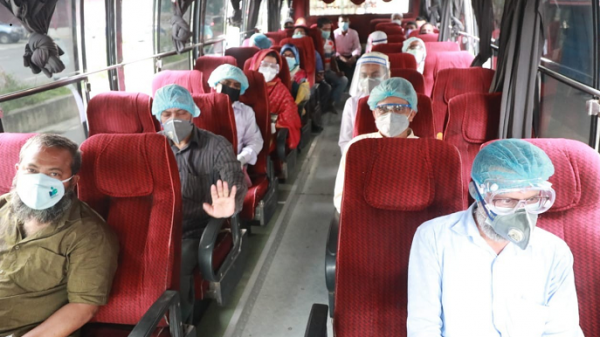Public transport exposing people to coronavirus risk

- Update Time : Sunday, September 13, 2020
- 169 Time View

Public transports are routinely flouting the government’s health guidelines, putting passengers at risk of contracting coronavirus.
Many local buses operating in the capital are seen carrying passengers more than their capacity and hardly any of them has sanitising equipment despite government instruction.
On May 31, the government reset the fares of long-haul buses and minibuses, hiking those by 60 percent in order to compensate the owners for carrying 50 percent less passengers to contain the transmission of coronavirus.
From Sept 1, normal fare has been restored and buses are allowed to run carrying 100 percent of their capacity. However, the government regulations require bus operators to place hand sanitisers and other hand washing essentials for passengers and to disinfect buses in between trips.
But the hassle for passengers has become worse. Ataur, a passenger travelling from Mirpur, said scuffles between passengers and conductors over fare are common now.
“We need to remind them that the previous rate has been restored but we still get overcharged at least by Tk 5 to 10. Normally the fare would’ve been Tk 25 from Rampura to Shahbagh. I had to pay Tk 40 till Aug 31 but now it’s Tk 30,” said Muntakim Rahman, a student of a public university.
‘Suffering increased’
According to Bangladesh Road Transport Authority (BRTA), mobile courts under executive magistrates are operating to take actions against such misdemeanors.
Road Transport and Bridges Minister Obaidul Quader on August 29 called upon the owners and workers to run vehicles following the health guidelines.
But alongside overloading, the bus operators show little to no concern about following hygiene rules. Some staff and passengers were seen without masks.
A conductor argued that passengers do not want to use sanitisers when boarding buses, prompting them to skip the step. But some passengers accused the bus operators of not paying attention to health guideline.
“We board these vehicles risking our lives because we have no other means of transport to travel. The drivers and conductors don’t comply with the health regulations and carry excess passengers that increase the chance of infection,” a passenger said.
Another passenger Raihan pointed out that the number of buses has not increased to the point it was before the restrictions were imposed.
“Still fewer buses are operating at the moment despite the government lifting the restrictions. It has exponentially increased the sufferings of passengers, especially after midday,” he said.
How safe is public transport?
Bangladesh has so far recorded 332,970 coronavirus cases and 4,634 deaths.
Flouting health guidelines on public transport, such as not wearing masks or disinfecting the surface, could cause many to catch the virus but there are ways to minimise risk.
The main way that the virus spreads is through droplets people spray when they talk, cough or sneeze. That means the best way to reduce the spread of infection on public transit and elsewhere is to wear mask and stay 6 feet from others, experts said.
But that rule is not followed as bus operators are carrying passengers in full capacity. This means, there is hardly any space between passengers sitting side by side. And on top of that many do not wear masks.
The US Centers for Disease Control and Prevention suggests traveling during non-peak hours, avoiding crowded spots in stations and stops, and skipping rows between seats when possible.
Surfaces are also believed to pose a risk, though to a lesser degree, and transit systems are employing a variety of cleaning techniques. The CDC says to avoid touching surfaces such as turnstiles and handrails if you can.
Though much remains unknown about the virus and how it spreads, experts note there have not yet been any major outbreaks linked to transit systems.















